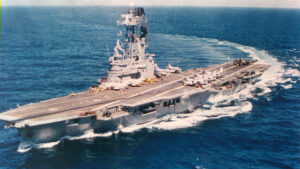
The ARA Veinticinco de Mayo (V-2), no. 1 of the Argentine Navy, was a light aircraft carrier of the Colossus class that served between 1970 and 2000. It previously joined the Royal Netherlands Navy between 1949 and 1970 as HNLMS Karel Doorman (R81) and the British Royal Navy between 1945 and 1949 as HMS Venerable (R63).
She was built at the British shipyard Cammell Laird & Co. in Birkenhead. The then HMS Venerable operated in the Royal Navy until 1949, the year in which she joined the ranks of the Royal Netherlands Navy. This country sold its HRMS Karel Doorman to Argentina in 1968. Being ARA Veinticinco de Mayo, it fought in the Falklands War as part of Task Force 79. Its final destination was scrapping in India in the 1990s due to the very high costs. that it cost the country to maintain said aircraft carrier.
#argentinaday #coldwar #colossusclass #aicraftcarrier #independencia #armada #armadadeargentina
Origin
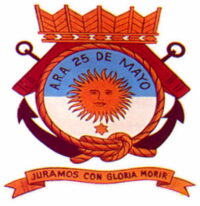 HMS Venerable (R63) was a Colossus class 1942 light fleet carrier program vessel ordered to Cammell Laird & Co. shipyard in Birkenhead with her keel laid down on 3 December 1942, launched on 23 February 1943 and completed on January 17, 1945. She served at first witrh the RN from 1943 to 1948, missing the war as she entered service by mid-1945 and never ventured to the Pacific, she was still training when the war ended this summer. At the time when her deployment to the BPF was cancelled she had received her full complement of Barracuda aircraft and Corsair.
HMS Venerable (R63) was a Colossus class 1942 light fleet carrier program vessel ordered to Cammell Laird & Co. shipyard in Birkenhead with her keel laid down on 3 December 1942, launched on 23 February 1943 and completed on January 17, 1945. She served at first witrh the RN from 1943 to 1948, missing the war as she entered service by mid-1945 and never ventured to the Pacific, she was still training when the war ended this summer. At the time when her deployment to the BPF was cancelled she had received her full complement of Barracuda aircraft and Corsair.
Next for budgetary reasons, the British Government started to get rid of “surplus carriers” and sell them after refits to keep shipyards workers busy. She was then sold to the Netherlands Navy in 1948 and after comprehensive refits, served until 1969. Contract was signed on April 1, 1948, and she was renamed HMNS Karel Doorman, she went into dry dock until early 1949 for a first overhaul modernization. Her rich career included sorties to the trubled ex-Dutch East Indies (now Indonesia) and she practices maneuvers with the United States Navy, notably focusing on ASW warfare,n her role withing NATO.
After ten years of service with the Dutch Navy she entered Feijenoord shipyard for a major reconstruction and modernization changing her original appearance and allowed her to deploy jet aircraft, modifying the flight and providing a powerful catapult, reinforced flight deck and lifts, in order to allow takeoff of aircraft. In 1967, she had a major fire causing the Dutch authorities to withdraw her from service. After 20 years she had 8,668 landings and 8,300 catapultings under her belt. On April 29, 1968 she had a major boiler accident as well.

Doorman before her departure for Argentina in 1969.
The Argentine Navy needed an aircraft carrier at the time capable of launching jet aircraft unlike ARA Independencia (ex-HMS Warrior), its first aircraft carrier. After repairs as Argentina was interested to purchase her at Wilton Fijenoord Shipyard, a commission went to determine the general condition of the ship, and the advantages offered by her angled deck, high-power US steam catapult and a top of the line electronics. The purchase was greenlighted and backed by the Government on September 16, 1968. She had extended modifications and extra repairs in the Netherlands until a small crew of Argentinian officers and non-commissioned officers started training here under command of captain Tirso Brizuela.
On August 8, 1969, she joined officially the Argentine Navy under the name ARA Veinticinco de Mayo (V-2). This was the start of a career which ended in 1997, making on of the oldest Colossus class carriers in service worlwide (beaten by the Indian Viraat).
Design of the class
Hull and general design
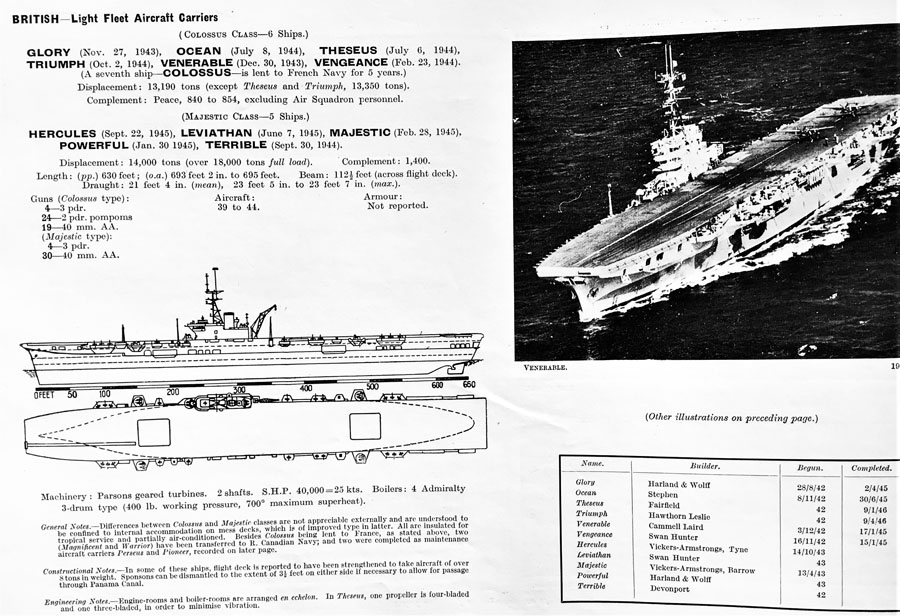
The Originak carrier had the following specs: 19,900 tons, 192 m (629 ft 11 in) long, 24.4 m (80 ft 1 in) wide at waterline level, for a draught of 7.5 m (24 ft 7 in).
She was powered by four boilers with steam turbines on two shafts for 40,000 shp (30,000 kW) making for a top speed of 24 knots (44 km/h). These were originally not frontline, but support fleet carriers, originally tailored to resupply and repair the air groups of armoured carriers in the Pacific. Complement was 1,300 and she was armed with 12 × 40 mm AA guns. Air group diverged as aircraft became larger, from 24 she fell to 21 at the end of her career.
Protection
Same as the origin, inherited from the base Colossus design but reduced to mantlets around aircraft torpedoes warheads rooms, 10mm (0.4 in). She also kept the original longitudinal watertight bulkheads covering the machinery. She also gained active protection system, decoy throwers and EW systems (see sensors).
Powerplant
21 de Mayo’s propulsion consisted of two sets of direct drive Parsons Compound turbines, each composed of a high pressure turbine and a low pressure turbine. Each could independently drive the shaft axle through a simple reduction box. Each unit was rated for 20,000 HP at 230 rpm, so 40k total. Direct current was provided by a plant composed of two 220 V DC turbogenerators, 500 kW 2200 A each and two auxiliary 200 kW diesel generators. Alternating current was provided by two turbo alternators of 440 V three-phase, 60 Hz and 450 kW, with two converters powered by the DC network in emergency cases. Veinticinco de Mayo was air-conditioned as well.
Armament
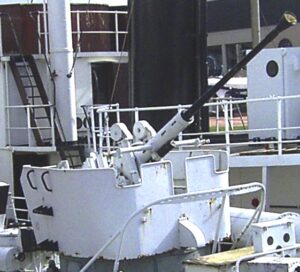 She had twelve 40mm/70 Bofors Mod 1958 inherited from the ancient configurations. They were still an asset in 1982 thanks to the associated fire control, however they would be incapable of stopping Sea Harriers if sent in a bombing mission against her. They were all shielded, located on the left forward sponson (the right one supported a service boat), two forward of the island, one on deck, the other superfiring, then two after of the island one on an upper platform, the other on deck. The remainder were located on the two aft sponsons.
She had twelve 40mm/70 Bofors Mod 1958 inherited from the ancient configurations. They were still an asset in 1982 thanks to the associated fire control, however they would be incapable of stopping Sea Harriers if sent in a bombing mission against her. They were all shielded, located on the left forward sponson (the right one supported a service boat), two forward of the island, one on deck, the other superfiring, then two after of the island one on an upper platform, the other on deck. The remainder were located on the two aft sponsons.
Sensors
At first the carriers came out with US and Dutch systems, the LW-01, LW-02, DA-01, as well as two VI-01 for fire control and the ZW-01 radars. They have changed on several occasions, and comprised:
-Two early warning radars LW-01 and LW-02
-Target acquisition and tracking radar DA-02
-Surface navigation/early warning radar ZW-01
-SGR-109 altimetric radar
-ECM (electronic countermeasures) equipment
-TACAMO URN-20 antenna (inside a tube filled with liquid hydrogen)
-Data link equipment to Type 42 destroyers ARA Hércules (D-1) and ARA Santísima Trinidad (D-2) systems, as they were her dedicated escorts.
Later, in her 1981 refit, two 40mm/70 were removed as the DA-01 radar. It was replaced by a DA-05 radar, as well as the CAAIS CCS installed and flying deck slightly enlarged.
In 1983 another 40mm/70 was removed and her CAAIS CCS was replaced by a SEWACO CCS.
Post-Falklands her LW-01, two VI-01, and DA-05 radars were removed and instead was imported the Dutch LW-08, DA-08, as well a French Decca RM1226, as well as the VI-109 and MM/SPN-720 radars.
Facilities
The flight deck measured 210.3m (689 ft) x 36.9m (118 ft) and 6,500 m² (69,965 ft sq) in surface.
The hangar measured 138.7m (453 ft)x 15.8m (50 ft)x 5.3m (16 ft) for 2,142m² (23,056 ft sq) surface and 11,355m³ (400,291 ft cu) in volume.
Two lifts, both measuring 13.7m (49 ft)x 10.4m (32 ft), capacity 6.8t.
One port (right) side catapult BH-III (6.4t plane was launched at 122km/h), angled towards the centerline and prolongated by a lip.
Aircraft fuel stowage was 448,200 liters.
The catapult was manufactured by Brown Bross Ltd of Edinburgh in Scotland, British Steam type 4, series 9, 199 feet in lenght, 174 ft of pulling force, towing capacity ranging from 15,000 to 30,000 lbs, max. empty speed 303 knots, total steam pressure 300 PSI. It comprised two 18-inch diameter cylinders mounted in parallel in a cradle flush within the flight deck. Inside both cylinders ran pistons driven by high-pressure steam connected to a bogie and strobe emerging from the flight deck on which to pass the towing hook). The pressure necessary for each launch depended on the weight and takeoff speed required for each aircraft. It could propel any 30,000 lbs model up to 110 knots (114 originally) with acceleration of 6 knots for every 1,000 lbs. A 22,500 lb A-4Q Skyhawk thus could be launched at 121.5 knots, without any addon wind over deck manoeuver, with its full bomb load.
Air Group

She could carry up to 24 aircraft. The air group started with F9F Panthers and F9F Cougar jets and later these were replaced with A-4Q Skyhawks supported by S-2 Tracker anti-submarine warfare aircraft and Sikorsky Sea King helicopters. The GAE evolved according to the additions made by the Navy. On her first missions she carried the Grumman S-2 Tracker ASW twin prop patroller, and North American Aviation T-28P (Trojan/Fennec) aircraft, a navalized training model converted for attack operations, as well as a pair of Sikorsky S-58 helicopters multirole, troop transport, SAR and ASW, liaison, and later replaced by Sud Aviation Alouette III in the latter ASW coop role.

A4Q Skyhawk. Note the small hump close to the fin. These models, the only jets to opertate from the carrier, started operating from land after the sinking of Belgrano.
In 1972 sixteen Douglas A-4B attack jets were purchased from the United States with modifications, designated as A-4Q. They formed the 3rd Naval Air fighter and Attack Squadron based at the Comandante Espora Air Naval Base. The A-4Qs was tasked of attacking surface units (ASuW) with braked bombs, as well as CAP for the task force with AIM-9B Sidewinder missiles, and in-flight refueling through “Buddy-buddy” underwing tanks for long missions.
Sargent Fletcher 31-300 (of Israeli origin) ensured it could also perform photographic reconnaissance missions by fitting the Israeli VICON 18 pod, equipped with six Vinten oblique photographic cameras.
The 21 de Mayo also received at this occasion Four Sikorsky S-61D Sea King helicopters for ASW operations with a 5th acquired in 1975 for special operations.
In 1978, six Grumman S-2E Trackers were acquired with updated eklectronics and equipments for anti-submarine operations, while the older ones were converted for liaison and logistics. A single Aérospatiale Alouette III with floats was also acquired for liaison, plane guard and SAR.
After modifications to her flight deck and braking system in 1979, the carrier was made able to operate the Dassault Super Étendard, forming a mixed group with Douglas A-4, the S-2 Tracker, S-61D Sea King helicopters and Alouette III. The Super Etendard in 1982 were capable of operating the Exocet missile, extending radically the lethality range of the carrier.

⚙ 1969 specifications |
|
| Displacement | 15,892 tonnes standard, 19,896 tonnes FL |
| Dimensions | 211.1 m oa(192 pp) x 36.9 x 7.6m (693 x 121 x 25 ft)) |
| Propulsion | 2 shafts Parsons Turbines, 4 adm. 3-drum boilers |
| Speed | 42,000 shp, 24 knots, Fuel 3,200 tons |
| Armament | 12 x 40 mm AA, 22 aircraft. |
| Sensors | LW-02, SGR-103/105 radars, TACAN, CAAIS information system. |
| Air Group | 21, see notes |
| Crew | 1250 |
Career of 21 de Mayo
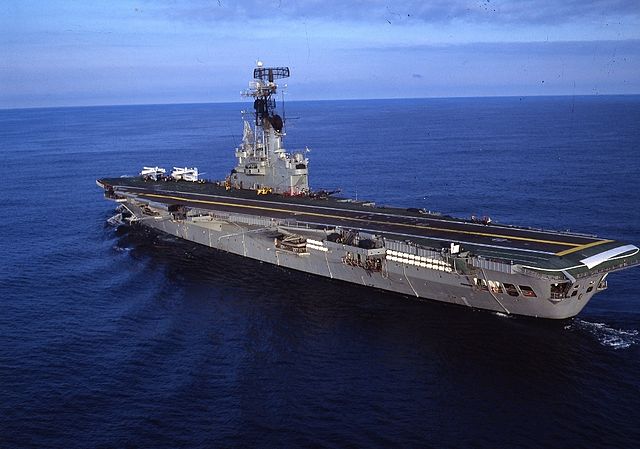
When she departed from the Netherlands, her crew was reduced to 350 men (normal 1000, later in her career 1400) and she hoisted the national flag on September 3 when leaving Rotterdam, arriving safely at Puerto Belgrano Naval Base on September 27. She entered the base and officially joined the Sea Fleet. After gathering her full crew se started a shakedown training, weapons and senors qualifications, and soon the first landings and takeoffs.
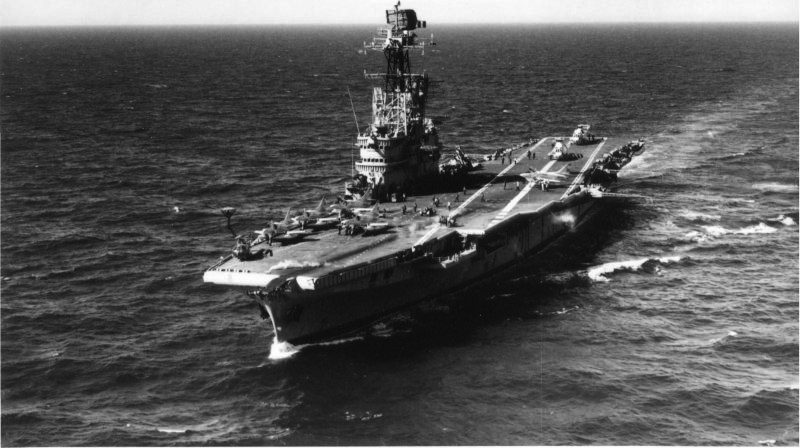
From 1970, she became fleet’s flagship, participating an yearly maneuvers and exercises and visiting Buenos Aires. On January 10, 1972 she sailed to the United States, New York on the 28th to embark sixteen recently purchased and converted Douglas A-4Q Skyhawk fighters and their associated ammunition and cargo.
In the the Argentina-Chile crisis of 1978, she was sent in the contested waters, leading an important fleet of boh surface vessels and and submarines as a show of force called Operation Sovereignty, which was canceled by Argentina underway. The intervention of Pope John Paul II prevented the confrontation and the whole fleet sailed back to Puerto Belgrano.
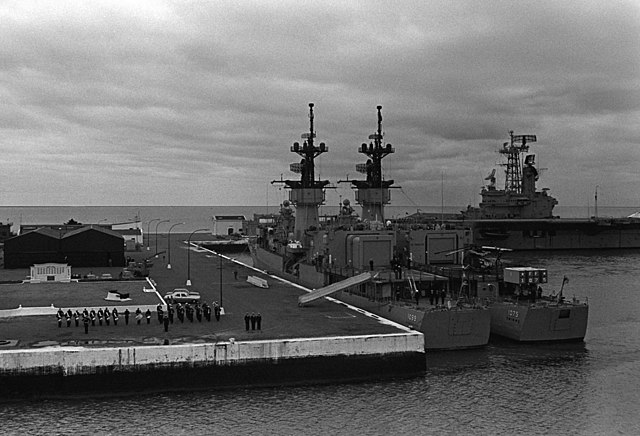

21 de Mayo in Puerto Belgrano 1979, UNITAS XX
Falklands conflict:
On March 23, 1982, the Military Junta ordered the invasion of the Falklands (Malvinas) through Act No. 4 “M”/82.3. To achieve this, the Naval Aviation Command created three naval air groups, Coastal, Insular and carrier-based. Meanwhile, the Squadron for 21 de Mayo was prepared at the Comandante Espora Naval Air Station, notably the 1979 acquired Dassault Super Etendard.
Operation Blue started, with 21 de Mayo as the centerpiece of Task Force 20, covering Task Force 40, the invasion force. ARA Veinticinco de Mayo took over the whole operation as fleet flagship for FT-206, leaving Puerto Belgrano on March 28, with on board three A-4Q Skyhawk from EA33, five S-2E Tracker from EA2S, three SA316 Alouette III from EAH1 and one SH-3 Sea King from EAH2.
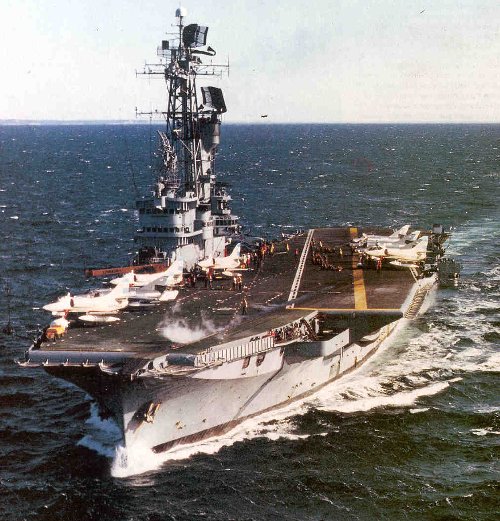
The amphibious assault was carried out as planned, with Puerto Argentino taken without resistance on 2nd of April. The island defenses were all attacked and eventually in Port Stanley, outnumbered British forces surrendered by order of Governor Rex Hunt. There was only one Argentine casualty, no British one. The troops had to behave in such a way this would not cause a case of legitimate defense. Combats in urban areas were avoided. On April 4, mission accomplished, the task forces returned to Puerto Belgrano to a hero’s welcome.
ARA Veinticinco de Mayo returned to provide air cover for the full island occupation, but started to showing her age, and suffered from the lack of maintenance. Still, she launched daily her A-4Q Skyhawk, S-2 Tracker and helicopters. The air group also suffered maintenance issue due to the US arms embargo. British intelligence services ruled out the use of the Super Étendard with Exocet from the aircraft carrier but still considered it a major threat to the fleet dispatched in the Falklands by order of PM M. Thatcher.
On April 14, the submarine HMS Splendid (S106) reached a position between the islands and mainland to prey on passing bt Argentinian warships. She was ordered to advance north in search of Veinticinco de Mayo. RN rules of engagement did not allow to attack her however unless in self-defense. She was to shadown her at all times. On April 23, HMS Splendid detected indeed ARA Veinticinco de Mayo near Puerto Belgrano, very far from the British declared exclusion zone, and could opnly took pictures of her from the periscope. A request to change the rules of engagement was refused by Downing Street. Given the proximity of the British Task Force on 24 April, HMS Splendid was ordered to prepare again to attack the carrier. Two days later, the British submarine found her escorting destroyers Hércules and Santísima Trinidad sailing along the Argentine coast towards the south. Splendid was ordered to abandon contact and search for the aircraft carrier to the north.
On April 28, the total exclusion zone (ZET) centered on the Falklands was declared and on the 30th, after a debate, the British War Cabinet changed the engagement rules, enabling the possibility to attack the aircraft carrier or any other Argentinian warhsip outside the ZET by surface vessels or submarines, even without self defence… except if located north of parallel 35° S and west of meridian 35° W, within 12 nautical miles of the Argentine coast. The head of the British Task Force, Admiral John Woodward sent a Sea Harrier in recce mission in order to detect the carrier with her own radar and located her with escorts at 200 nmi northeast of the British Task Force.
The Task Argentine Task Group detected the Harrier and prepared on its side and attack on the British Task Force. Thius was to be Midway in South American waters… 21 de Mayo prepared a launch of six A-4Q planes loaded each with four 250 kgs Mark 82 bombs but the lack of favorable wind to take off prevented this. Still the Argentinain naval staff prepared a pincer movement between the ARA Veinticinco de Mayo TF and ARA General Belgrano cruiser TF. The British detected the second force and decided to attack instead, with the nuclear submarine HMS Conqueror (S48), shadowing her and waiting for orders launching three torpedoes, two hitting. The cruiser sank with 323 crew members. The third torpedo hit the destroyer ARA Bouchard (D-26). After the schok cause by the attacj, the pincer plan vanished and the naval command decided to withdraw the aircraft carrier to shallower waters. This incidentally was withing 12 nm from the shore and thus, the British could not attack her.
While on the way back the Carrier TF escorts had a positive (possible) contact with a submarine but it was never confirmed. It was decided that from now on, attacks on British forces will be done from land bases. The carrier still received the “Combat Operations” decoration by Resolution No. 08/83. She never sailed again in anger until the end of the war nor conducted any attack from her deck. She was inoperative from June 1986 due to constant machinery issues.
End of service 1988-97
By late 1988, an ambitious program of modernization was set in motion at the Río Santiago Shipyard to change worn out propulsion plant, and all electronics. But it was cancelled due to the economic crisis in the first half of 1989. Due to her general state, the carrier never sailed operationally again from then on. She started to be cannibalized with parts sold to the Brazilian Navy, umaintaining NAeL Minas Gerais (A-11) of the same Class, notably the catapult, in order to operate in turn the Douglas A-4KW fleet acquired from Kuwait in 1998. By resolution of the Chief of Staff Carlos Marrón on March 5, 1997, 21 de Mayo was barred from any further modification or modernization, stricken and placed on the sales list on February 1997. In 2000, she was sold to a shipbreaker in Alang, India and rowed there to be scrapped.
Read More/Src
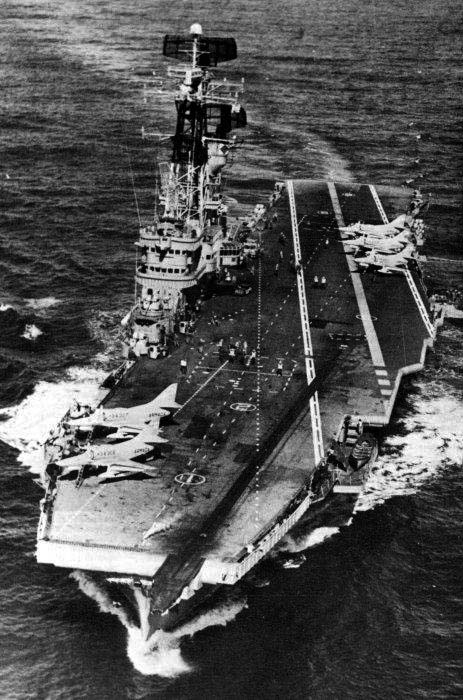
Books
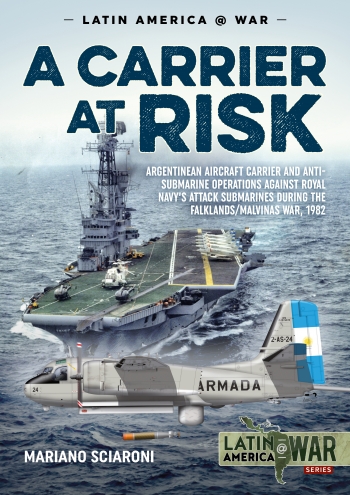
Baker, A. D. III, ed. (1998). The Naval Institute Guide to Combat Fleets of the World 1998–1999. Annapolis, Maryland, USA: Naval Institute Press. ISBN 1-55750-111-4.
Burden, Rodney A.; Draper, Michael I.; Rough, Douglas A.; Smith, Colin R.; Wilton, David (1986). Falklands: The Air War. British Aviation Research Group. ISBN 0-906339-05-7.
Gardiner, Robert; Chumbley, Stephen, eds. (1995). Conway’s All The World’s Fighting Ships 1947–1995. Annapolis, Maryland, USA: Naval Institute Press. ISBN 1-55750-132-7.
Hobbs, David (2013). British Aircraft Carriers: Design, Development and Service Histories. Barnsley, UK: Seaforth Publishing. ISBN 978-1-84832-138-0.
Ireland, Bernard (2007). The Illustrated Guide to Aircraft Carriers of the World. London: Anness Publishing Limited, Hermes House. p. 147. ISBN 978-1-84477-747-1.
Moore, John, ed. (1985). Jane’s Fighting Ships 1985–86. London: Jane’s Yearbooks. ISBN 0-7106-0814-4.
Bishop, Chris; Chris Chant (2004). Aircraft Carriers. London: Summertime Publishing Ltd. p. 83. ISBN 0-7603-2005-5.
Donald, David; Daniel J. March (2001). Carrier Aviation Air Power Directory. Norwalk, CT: AIRtime Publishing. p. 91. ISBN 1-880588-43-9.
Secondi, Martín; Jorge A. Leguizamón (1999). 25 de Mayo Portaaviones (in Spanish). Buenos Aires, Argentina: Ayer y Hoy Ediciones. p. 72. ISBN 987-9249-06-2.
Links
web.archive.org fuerzasnavales.com/
argentina.gob.ar/defensa/armada
web.archive.org Portaaviones/25deMayo.htm
skyhawk.org/ argentine-third
navypedia.org independencia class
es.wikipedia.org ARA_Veinticinco_de_Mayo V-2
https://www.infodefensa.com/texto-diario/mostrar/3126050/super-etendard-argentinos-estarian-operativos-anos
https://en.mercopress.com/2021/05/26/argentine-air-force-faces-another-hurdle-for-its-re-equipment-plans
https://books.google.fr/books?id=BEjOdVzx9UcC&redir_esc=y
https://www.globalsecurity.org/military/library/report/1984/HJA.htm
https://web.archive.org/web/20080921061853/http://www.raf.mod.uk/falklands/an1.html
https://web.archive.org/web/20050424130640/http://www.globalsecurity.org/military/world/argentina/25-de-mayo.htm
Videos
Model Kits
kit review 1/350, Eigenbau on modellmarine.de

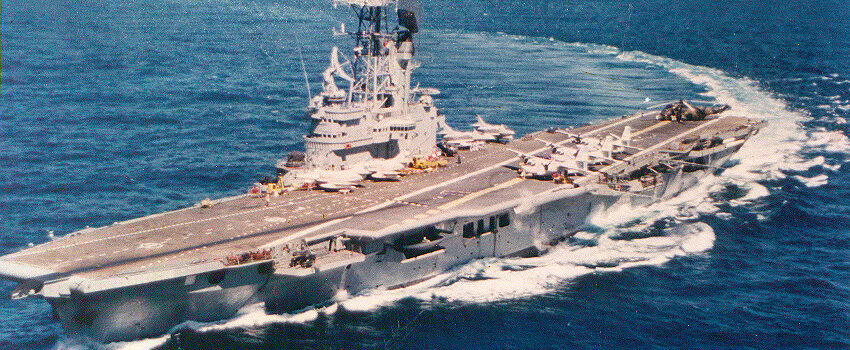

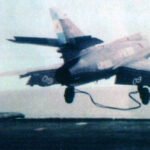
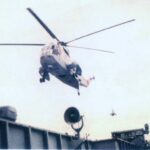
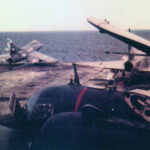
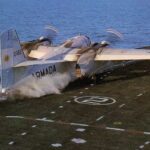
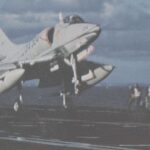

 Latest Facebook Entry -
Latest Facebook Entry -  X(Tweeter) Naval Encyclopedia's deck archive
X(Tweeter) Naval Encyclopedia's deck archive Instagram (@navalencyc)
Instagram (@navalencyc)





 French Navy
French Navy Royal Navy
Royal Navy Russian Navy
Russian Navy Armada Espanola
Armada Espanola Austrian Navy
Austrian Navy K.u.K. Kriegsmarine
K.u.K. Kriegsmarine Dansk Marine
Dansk Marine Nautiko Hellenon
Nautiko Hellenon Koninklije Marine 1870
Koninklije Marine 1870 Marinha do Brasil
Marinha do Brasil Osmanlı Donanması
Osmanlı Donanması Marina Do Peru
Marina Do Peru Marinha do Portugal
Marinha do Portugal Regia Marina 1870
Regia Marina 1870 Nihhon Kaigun 1870
Nihhon Kaigun 1870 Preußische Marine 1870
Preußische Marine 1870 Russkiy Flot 1870
Russkiy Flot 1870 Svenska marinen
Svenska marinen Søværnet
Søværnet Union Navy
Union Navy Confederate Navy
Confederate Navy Armada de Argentina
Armada de Argentina Imperial Chinese Navy
Imperial Chinese Navy Marinha do Portugal
Marinha do Portugal Mexico
Mexico Kaiserliche Marine
Kaiserliche Marine 1898 US Navy
1898 US Navy Sovietskiy Flot
Sovietskiy Flot Royal Canadian Navy
Royal Canadian Navy Royal Australian Navy
Royal Australian Navy RNZN Fleet
RNZN Fleet Chinese Navy 1937
Chinese Navy 1937 Kriegsmarine
Kriegsmarine Chilean Navy
Chilean Navy Danish Navy
Danish Navy Finnish Navy
Finnish Navy Hellenic Navy
Hellenic Navy Polish Navy
Polish Navy Romanian Navy
Romanian Navy Turkish Navy
Turkish Navy Royal Yugoslav Navy
Royal Yugoslav Navy Royal Thai Navy
Royal Thai Navy Minor Navies
Minor Navies Albania
Albania Austria
Austria Belgium
Belgium Columbia
Columbia Costa Rica
Costa Rica Cuba
Cuba Czechoslovakia
Czechoslovakia Dominican Republic
Dominican Republic Haiti
Haiti Hungary
Hungary Honduras
Honduras Estonia
Estonia Iceland
Iceland Eire
Eire Equador
Equador Iran
Iran Iraq
Iraq Latvia
Latvia Liberia
Liberia Lithuania
Lithuania Mandchukuo
Mandchukuo Morocco
Morocco Nicaragua
Nicaragua Persia
Persia San Salvador
San Salvador Sarawak
Sarawak Uruguay
Uruguay Venezuela
Venezuela Zanzibar
Zanzibar Warsaw Pact Navies
Warsaw Pact Navies Bulgaria
Bulgaria Hungary
Hungary

 Bundesmarine
Bundesmarine Dutch Navy
Dutch Navy Hellenic Navy
Hellenic Navy Marina Militare
Marina Militare Yugoslav Navy
Yugoslav Navy Chinese Navy
Chinese Navy Indian Navy
Indian Navy Indonesian Navy
Indonesian Navy JMSDF
JMSDF North Korean Navy
North Korean Navy Pakistani Navy
Pakistani Navy Philippines Navy
Philippines Navy ROKN
ROKN Rep. of Singapore Navy
Rep. of Singapore Navy Taiwanese Navy
Taiwanese Navy IDF Navy
IDF Navy Saudi Navy
Saudi Navy Royal New Zealand Navy
Royal New Zealand Navy Egyptian Navy
Egyptian Navy South African Navy
South African Navy






























 Ukrainian Navy
Ukrainian Navy dbodesign
dbodesign